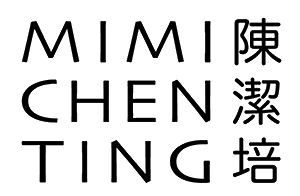A Conversation with Mimi Chen Ting
I discovered Mimi Chen Ting from her association with the ICB studios in Sausalito. From the first time I saw Mimi Chen Ting’s work, I’ve been curious about the artist who could create such beauty with simply line and color. Having the opportunity to ask Mimi some of the most basic questions, I now have the opportunity to share with all of you what makes this acclaimed artist so special.
As always, I hope you enjoy our conversation as much as I did.
Brian Siedlecki: When did you first realize that you had a talent for art?
Mimi Chen Ting: Since first grade in Hong Kong, I had been asked (told) by the nuns to make feast-day cards and Christmas decorations. Perhaps they were the first to realize I had a talent for art (which I would just call an insatiable longing to make visible). When I came to the United States to attend university, I began with a double major in English Literature and Sociology, while taking extra credit for any art classes I could find and get into. At the end of my junior year, I realized creative work had the strongest pull. I simply surrendered and heeded the call.
Siedlecki: What is your favorite medium and why?
Chen Ting: I just do what I love.
I love making marks on a virgin ground with no preconceived notions or expectations. It is a time of ultimate adventure, allowing the lines and layers to accumulate and fester until out of the necessary but utter confusion, they sort of find their own hierarchy. My job is mostly to allow and listen. Then about ¾ of the way into the piece, I generally can begin to sense the gist of what it is, and begin the process of what I call shaping (selective emphases and erasures). The last step of the process is detailing, where I much like a car detailer, clean-up and “polish” the work until it arrives at an agreeable level (between me and the painting) of dynamic balance and resonant clarity.
Siedlecki: How do you choose your subjects?
Chen Ting: I am a political wonk and an opera addict. I have a very rich family life, as well as serve as devoted companion to my dog. I am a home-body and a nomad. I have for a long time practiced dance, yoga, Tai Chi, and butoh. I am affected by everything that happens around me. I do not consciously choose my subjects.
Siedlecki: What is it about you that makes you a good artist?
Chen Ting: I am patient and impatient, curious and unafraid. When I am working, I am constantly aware of the great legacy of my profession. I toil in the shadows of men and women from every generation whose mission has been to find unique ways of seeing and telling about things as old as time. It makes me feel very humble and grateful for my opportunity to do the same. I don’t know if that makes me a good artist, but I know it makes me tireless, irrepressible, and full of purpose when I step into my studio and begin a day’s work.
Siedlecki: As an artist, what type of art do you appreciate?
Chen Ting: I love and admire art that challenges and inspires me. I like seeing the hand of the artist in the work, as well as his/her journey. I am especially drawn to work that invites me to become more open and allows me to find resonance with it.
Siedlecki: Many people are concerned about spending money on art given the state of our economy. What would you tell them?
Chen Ting: Because I have the great fortune to live and work my passion, and must still manage to pay the rent on my studio, and for the occasional visit to the dentist, I do appreciate the real and pressing concerns of the economy. But I say, treating yourself to something you love, is a treat indeed, in any circumstance.
Siedlecki: What would you tell artists that believe fine art should only be sold from galleries?
Chen Ting: I congratulate them if they are working with great dealers. But the world has changed. There are too many artists and just not enough brick-and-mortar galleries. I like the arcing reach of the Internet. It is a great way to reach a broader audience and engender dialogue and response to the work, which is after all, one of the most important components of an artist’s life.
